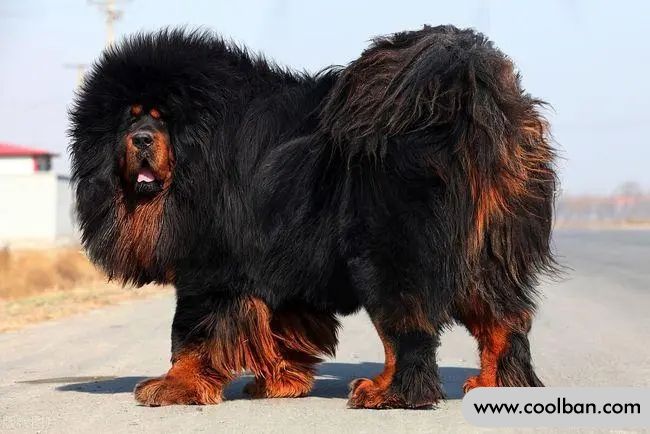How to raise a Tibetan Mastiff?
Tibetan Mastiff, AKC classification belongs to the working dog group. It belongs to the Hequ area of Gannan Tibetan Autonomous Prefecture, Gansu Province, and belongs to the Qinghai-Tibet Plateau of China. It is also called Tibetan Mastiff. It is a national second-class protected animal. It plays a huge role and is known as the "God of the East". The Tibetan Mastiff is the only dog breed in the world that is not afraid of wild animals. Historically, it has been regarded as the watchdog and protector of the Tibetans. Now mostly used as livestock dogs, family guard dogs and military dogs.
Morphological characteristics of Tibetan mastiffs
The Tibetan Mastiff is native to the Qinghai-Tibet Plateau. It is a tall, fierce, lop-eared bulldog. In Tibetan serf society, only kings and monasteries had the right to keep them. The length is about 1.20 meters.
The purebred adult Tibetan Mastiff weighs 50 to 60 kilograms, is about 1 meter long, and has a shoulder height of more than 0.6 meters. Even if it is resting, its appearance is fierce, and ordinary people will never dare to approach it. The Tibetan Mastiff is as powerful as a tiger, fierce and aggressive, so it has a lot of records of hurting people, making it win the reputation of a god dog, and it is also the only dog in the world that is not afraid of wild animals.
Characteristics of Tibetan Mastiff
The bravery of the Tibetan Mastiff is the nature of the Tibetan Mastiff. They are loyal to their masters and are reckless and impulsive in life, but they are very intelligent. In their consciousness, mission is more important than life. Tibetan mastiffs are always arrogant and domineering, and they never get along with outsiders.
Feeding knowledge of Tibetan Mastiff
The Tibetan Mastiff is the oldest and rarest dog breed in the world. Its loyal and protective nature is not only the best protection dog for nomads, but also recognized as the king. Tibetan Mastiffs are more sensitive to living environment and nutrients intake. The female Tibetan Mastiff consumes a certain amount of physical strength after giving birth, and has to feed the cubs, resulting in poor physical condition and poor physique. One is to meet the nutritional needs of the bitch's body, and the other is to ensure that the bitch provides enough milk for the puppies, because the nutrition of the puppies must be obtained from milk at this time, and enough milk can ensure their normal growth and development.

Feeding points of Tibetan Mastiff
It is not an exaggeration to describe the Tibetan Mastiff's body with its backs and waists. Since the Tibetan Mastiff is produced in Tibet, it can adapt to the cold climate. In terms of feeding, in addition to balanced nutrition, you should also consume enough protein and fat.
1. Protein: Adult Tibetan Mastiffs need to digest more than 5 grams of protein per kilogram of body weight, of which animal protein should not be less than 1.6 grams per kilogram of body weight.
2. Carbohydrates: In Tibetan Mastiff's feed, carbohydrates are the most important and nutritious substances next to protein. Among the grains, cornmeal, wheat flour, rice, etc. can be used as carbohydrate feed for Tibetan mastiffs to supplement carbohydrates in Tibetan mastiffs.
3. Fat: Generally, the fat requirement of Tibetan Mastiff is 1.3 g/kg body weight per day for puppies and 1.2 g/kg body weight per day for adult dogs. Calculated according to the feed, it should reach 8% to 10%. Tibetan mastiffs have a special preference for the fat of cattle and sheep.
4. Vitamins: Vitamins are necessary substances for Tibetan Mastiff to maintain normal physiological function and metabolism. Must attach great importance to the nutritional ratio of Tibetan Mastiff. If vitamin supplementation is neglected during feeding, it often leads to multivitamin deficiency.
5. Water intake: Under normal circumstances, adult Tibetan mastiffs need more than 100-200 ml of water per kilogram of body weight per day, and puppies even reach 100-180 ml. During breeding, or when fed dry food, water intake must be increased.

Common misunderstandings of raising Tibetan mastiffs
1. Chicken frame instead of bones:
Mastiffs are large dogs and require large, edible animal bones, such as cow bones. These bones are rich in marrow and calcium and are very helpful for mastiffs, especially young mastiffs. A chicken frame is a sharp, broken bone that can easily pierce a mastiff's throat and stomach, which is not only unhelpful, but very dangerous.
2. Feed sweetened whole milk rice flour:
There are many types of milk, but Tibetan mastiffs must be fed unsweetened skimmed milk rice flour, because sugary whole milk rice flour can cause gastrointestinal discomfort, diarrhea and even dehydration in dogs. Especially sick Tibetan mastiffs should not be fed milk. If possible, adding bone meal to milk is especially beneficial for young mastiffs!
3. Overfeeding animal offal:
About the internal organs of animals. This is the food that Tibetan Mastiff likes to eat very much, and it is also very nutritious, but it must not be too much. If it is too much, it will cause Zhongyu reaction, which will seriously affect the growth of bones. Two livers in three weeks is a good ratio, otherwise the treatment will be troublesome.
4. Feed raw eggs:
Many people feed raw eggs or mix them with raw eggs after the food is cooked. Raw Eggs Linked to Vitamin H in Mastiffs Cancel each other out. Long-term feeding of raw eggs can cause enormous damage and damage to a mastiff's coat. This is a very wrong approach, only boiled eggs have a great supplementary effect on the nutrition of the mastiff. Moreover, it can only eat egg yolks. The protein of Tibetan mastiff is difficult to digest, so it is generally not recommended for dogs to eat.
